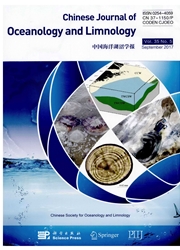

 中文摘要:
中文摘要:
A molecular phylogenetic analysis of the genus Scomber was conducted based on mitochondrial(COI,Cyt b and control region) and nuclear(5S rDNA) DNA sequence data in multigene perspective.A variety of phylogenetic analytic methods were used to clarify the current taxonomic classification and to assess phylogenetic relationships and the evolutionary history of this genus.The present study produced a well-resolved phylogeny that strongly supported the monophyly of Scomber.We confirmed that S.japonicus and S.colias were genetically distinct.Although morphologically and ecologically similar to S.colias,the molecular data showed that S.japonicus has a greater molecular affinity with S.australasicus,which conflicts with the traditional taxonomy.This phylogenetic pattern was corroborated by the mtDNA data,but incompletely by the nuclear DNA data.Phylogenetic concordance between the mitochondrial and nuclear DNA regions for the basal nodes supports an Atlantic origin for Scomber.The present-day geographic ranges of the species were compared with the resultant molecular phylogeny derived from partition Bayesian analyses of the combined data sets to evaluate possible dispersal routes of the genus.The present-day geographic distribution of Scomber species might be best ascribed to multiple dispersal events.In addition,our results suggest that phylogenies derived from multiple genes and long sequences exhibited improved phylogenetic resolution,from which we conclude that the phylogenetic reconstruction is a reliable representation of the evolutionary history of Scomber.
 英文摘要:
英文摘要:
A molecular phylogenetic analysis of the genus Scomber was conducted based on mitochondrial (COI, Cyt b and control region) and nuclear (5S rDNA) DNA sequence data in multigene perspective. A variety of phylogenetic analytic methods were used to clarify the current taxonomic classification and to assess phylogenetic relationships and the evolutionary history of this genus. The present study produced a well-resolved phylogeny that strongly supported the monophyly of Scomber. We confirmed that S. japonicus and S. colias were genetically distinct. Although morphologically and ecologically similar to S. colias, the molecular data showed that S. japonicus has a greater molecular affinity with S. australasicus, which conflicts with the traditional taxonomy. This phylogenetic pattern was corroborated by the mtDNA data, but incompletely by the nuclear DNA data. Phylogenetic concordance between the mitochondrial and nuclear DNA regions for the basal nodes supports an Atlantic origin for Scomber. The present-day geographic ranges of the species were compared with the resultant molecular phylogeny derived from partition Bayesian analyses of the combined data sets to evaluate possible dispersal routes of the genus. The present-day geographic distribution of Scomber species might be best ascribed to multiple dispersal events. In addition, our results suggest that phylogenies derived from multiple genes and long sequences exhibited improved phylogenetic resolution, from which we conclude that the phylogenetic reconstruction is a reliable representation of the evolutionary history of Scomber.
 同期刊论文项目
同期刊论文项目
 同项目期刊论文
同项目期刊论文
 AFLP analysis on genetic diversity and population structure of small yellow croaker Larimichthys pol
AFLP analysis on genetic diversity and population structure of small yellow croaker Larimichthys pol Isolation and characterization of polymorphic microsatellite loci in golden cuttlefish (Sepia escule
Isolation and characterization of polymorphic microsatellite loci in golden cuttlefish (Sepia escule Limits of Bayesian skyline plot analysis of mtDNA sequences to infer historical demographies in Paci
Limits of Bayesian skyline plot analysis of mtDNA sequences to infer historical demographies in Paci Tissue-specific accumulation of cadmium and its effects on antioxidative responses in Japanese floun
Tissue-specific accumulation of cadmium and its effects on antioxidative responses in Japanese floun First record of red filament threadfin bream, Nemipterus marginatus (Valenciennes, 1830) from Chines
First record of red filament threadfin bream, Nemipterus marginatus (Valenciennes, 1830) from Chines Redescription of the notchedfin threadfin bream Nemipterus peronii from southern coastal areas of Ch
Redescription of the notchedfin threadfin bream Nemipterus peronii from southern coastal areas of Ch Molecular phylogeny and evolution of Scomber (Teleostei: Scombridae) based on mitochondrial and nucl
Molecular phylogeny and evolution of Scomber (Teleostei: Scombridae) based on mitochondrial and nucl Isolation and characterization of microsatellite markers for the Korean rockfish, Sebastes schlegeli
Isolation and characterization of microsatellite markers for the Korean rockfish, Sebastes schlegeli A NEW RECORD SPECIES OF THE HEADRABBIT PUFFER, LAGOCEPHALUS LAGOCEPHALUS (LINNAEUS, 1758) FROM CHINA
A NEW RECORD SPECIES OF THE HEADRABBIT PUFFER, LAGOCEPHALUS LAGOCEPHALUS (LINNAEUS, 1758) FROM CHINA Population Genetic Studies Revealed Local Adaptation in a High Gene-Flow Marine Fish, the Small Yell
Population Genetic Studies Revealed Local Adaptation in a High Gene-Flow Marine Fish, the Small Yell Polymorphic Microsatellite Markers in False kelpfish Sebastiscus marmoratus: Isolation, Characteriza
Polymorphic Microsatellite Markers in False kelpfish Sebastiscus marmoratus: Isolation, Characteriza Mitochondrial DNA control region diversity and population structure of Pacific herring (Clupea palla
Mitochondrial DNA control region diversity and population structure of Pacific herring (Clupea palla Isolation and characterization of 26 microsatellite markers for Japanese pufferfish, Takifugu rubrip
Isolation and characterization of 26 microsatellite markers for Japanese pufferfish, Takifugu rubrip Two new species and one newly recorded species of the genus Kamaka (Crustacea: Amphipoda) from the H
Two new species and one newly recorded species of the genus Kamaka (Crustacea: Amphipoda) from the H Development of 20 Microsatellite Markers for Solenocera crassicornis and Their Cross-Species Applica
Development of 20 Microsatellite Markers for Solenocera crassicornis and Their Cross-Species Applica Population genetic structure and demographic history of the small yellow croaker, Larimichthys polya
Population genetic structure and demographic history of the small yellow croaker, Larimichthys polya Isolation and characterization of New 24 Microsatellite DNA Markers for golden cuttlefish (Sepia esc
Isolation and characterization of New 24 Microsatellite DNA Markers for golden cuttlefish (Sepia esc Genetic diversity in the mtDNA control region and population structure in the small yellow croaker L
Genetic diversity in the mtDNA control region and population structure in the small yellow croaker L 期刊信息
期刊信息
